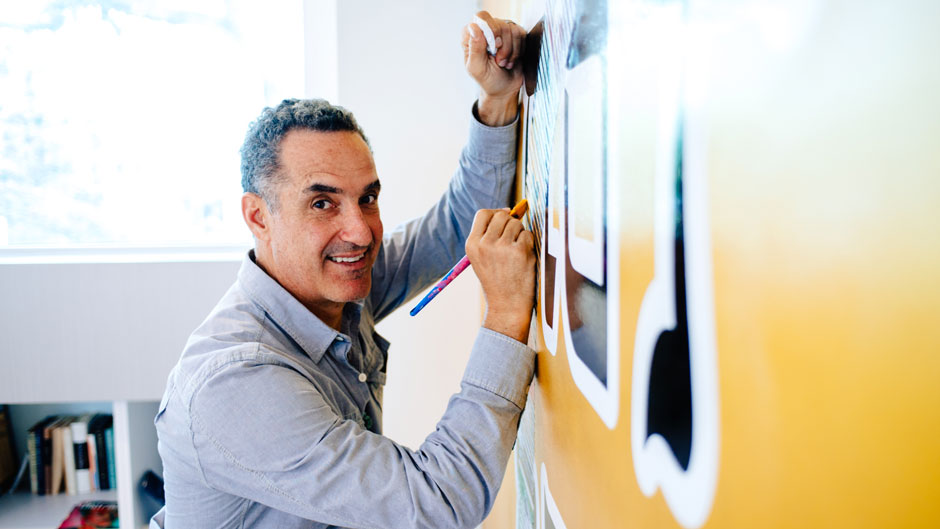For more than two years now, the renovated and expanded Braman Miller Center for Jewish Student Life has been the home for UM Hillel and a gathering haven for the University of Miami’s Jewish community. The state-of-the-art facility also thrives as a public venue, hosting such dignitaries as Peruvian President Pedro Pablo Kuczynski
What may not be as noticeable is the ongoing initiative to promote artistic endeavors. But take a closer look, and you will find art works donated by a UM student and other collectors hanging in the lobby and delightful quotes that convey motivational and creative messages throughout the building—even in unlikely places like the bathroom.
Now Debi Braman Wechsler, UM Hillel’s incoming chair and a Miami art enthusiast, wants to continue to feature artist’s works throughout the building.
A longtime friend of Stuart Sheldon, a Miami-based Jewish artist, writer and former UM student, she invited him to unleash his creativity on the space.
“We had built a beautiful building, but there were a lot of big white walls, and I wanted to bring it to life with colors and vibrancy for the students,” she explained. “Stuart came, saw the space, and loved it.”
She is “super-thrilled” by Sheldon’s donated work, an intriguing, metallic gold mural on a wall in the second-floor library.
“I knew the combination of Stuart’s energy and bold messages would be the perfect match,” said Braman Wechsler.
 At first glance, the painted mural appears to be written in traditional Hebrew script. But a closer look reveals the thought-provoking quote, ‘If not now, when?’ from the rabbinic sage Hillel the Elder, for whom Hillel organizations get their name. “If I am not for myself, who will be for me? If I am only for myself, what am I? If not now, when?” Hillel famously asked over 2,000 years ago.
At first glance, the painted mural appears to be written in traditional Hebrew script. But a closer look reveals the thought-provoking quote, ‘If not now, when?’ from the rabbinic sage Hillel the Elder, for whom Hillel organizations get their name. “If I am not for myself, who will be for me? If I am only for myself, what am I? If not now, when?” Hillel famously asked over 2,000 years ago.
The mural’s signature spiral, or in Sheldon’s words, the “vortex,” is composed of colorful book covers of literary classics, including “Catcher in the Rye” and “Catch 22,” that are deeply rooted in Jewish culture. Sheldon selected books that underscore how some of the world’s most influential and beloved novels were written by Jewish authors. He then converted each curated cover into an archival print, slicing and dicing it to show its most relevant angles.
“As a writer myself, it was important that the writer's name is displayed on each cover,” Sheldon said.
The mural already has proven to be an icebreaker for students, who have turned the library space into a hub of conversation and interaction.
“Students are fascinated to see the blend between ancient history mixed with contemporary works in Jewish literature and to learn that their favorite childhood books are deeply rooted in Jewish tradition,” said Igor Khokhlov, executive director of UM Hillel. “We love to see students engaging in ways that are relevant and meaningful to them.”
The mural is not, however, just something beautiful to look at. Like Braman Wechsler, Sheldon means it to be a call to action. He wants students to think about how their engagement can affect change for the better.
“This piece is going to be looked at by young minds that are hungry for knowledge, that are already socially engaged, already eager to learn,” Sheldon said. “I want everyone to have an active role in trying to fix the world because ‘if not now, when?”’

